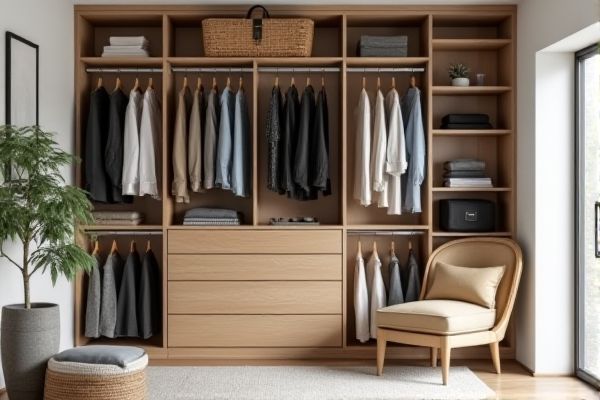
A seasonal closet organizes your wardrobe by storing off-season clothes separately, maximizing space and making outfit selection more efficient compared to a regular closet that holds all items year-round. Discover how switching to a seasonal closet can transform your daily dressing routine by reading the rest of this article.
Table of Comparison
| Feature | Seasonal Closet | Regular Closet |
|---|---|---|
| Purpose | Stores clothes by season (winter, summer, etc.) | Holds all clothing year-round |
| Space Efficiency | Optimizes space by rotating seasonal items | Can become cluttered, less organized |
| Organization | Clear seasonal separation, easier outfit planning | Mixed clothing, harder to sort |
| Maintenance | Requires seasonal swapping and storage | Low maintenance, no seasonal changes |
| Accessibility | Only current season accessible | All clothes accessible anytime |
| Suitability | Ideal for climates with distinct seasons | Fits any climate or lifestyle |
Understanding Seasonal Closets vs Regular Closets
Seasonal closets are designed to store clothing and accessories based on the time of year, making it easier to rotate your wardrobe and keep items organized according to weather changes. Regular closets typically house your entire wardrobe year-round, which can result in clutter and difficulty finding specific pieces quickly. Optimizing your storage with a seasonal closet system enhances space efficiency, protects off-season garments, and streamlines your daily outfit selection.
Key Differences Between Seasonal and Regular Closets
Seasonal closets are designed to store clothing specific to particular times of the year, such as winter coats or summer swimwear, while regular closets house your everyday wardrobe items. Seasonal closets optimize space by rotating garments based on weather and trends, reducing clutter and making it easier to access current essentials. You can enhance organization and extend the lifespan of your clothes by clearly distinguishing between these two closet types.
Benefits of a Seasonal Closet Organization
Seasonal closet organization enhances wardrobe management by allowing you to rotate clothing based on weather and trends, optimizing space and reducing clutter. It simplifies daily outfit selection, ensuring your most relevant garments are easily accessible while off-season items remain neatly stored. This method also extends clothing longevity by minimizing wear and exposure to elements when not in use.
Pros and Cons of a Regular Closet Setup
A regular closet offers constant accessibility to all clothing items, making outfit selection quicker and more convenient. However, it can easily become cluttered and overwhelming, reducing organization efficiency and making it harder to maintain. Limited space may also cause overcrowding, which can lead to clothing damage and decreased visibility of seasonal or rarely worn items.
Storage Solutions for Seasonal Clothing
Seasonal closets provide specialized storage solutions for your clothing by efficiently organizing items based on weather and occasion, reducing clutter in your regular closet. These systems often include adjustable shelving, vacuum-sealed bags, and labeled bins designed to protect delicate fabrics and maximize space. By rotating your wardrobe seasonally, you maintain easy access to your current attire while preserving off-season pieces in optimal conditions.
Decluttering Tips for Each Closet Type
For a seasonal closet, prioritize decluttering by assessing items based on current weather and upcoming seasons, removing off-season clothes to free up space and maintain organization. In a regular closet, focus on daily wear and frequently used items, donating or storing pieces you haven't worn in months to prevent overcrowding. Tailor your decluttering approach to your closet type to enhance convenience and optimize your wardrobe's accessibility.
Space Optimization Strategies
Seasonal closets utilize space optimization strategies such as rotating clothing storage based on weather and activity, allowing you to access your most relevant wardrobe items easily while keeping off-season pieces neatly tucked away. Regular closets often lack this dynamic approach, leading to overcrowding and inefficient use of storage areas. Implementing seasonal rotation maximizes your closet's capacity, enhances garment care, and streamlines daily outfit selection.
Clothing Rotation: When and How to Switch
Clothing rotation between seasonal and regular closets is essential for maintaining wardrobe organization and garment longevity. Switch your clothes at the start of each season by storing off-season items in breathable containers or vacuum bags to prevent damage and save space. Your efficient rotation schedule ensures easy access to weather-appropriate clothing and maximizes your wardrobe's usability year-round.
Maintenance Routines for Seasonal and Regular Closets
Maintaining a seasonal closet involves rotating clothes based on weather changes, including thorough cleaning and inspecting garments before storing them to prevent moth damage or fabric deterioration. Regular closets require consistent organization, frequent decluttering, and immediate laundering of worn items to ensure everyday accessibility and freshness. Both closet types benefit from using storage solutions like vacuum bags or breathable bins to optimize space and protect clothing quality year-round.
Choosing the Right Closet Type for Your Lifestyle
Seasonal closets optimize storage by rotating clothing based on weather, ideal for those with distinct seasonal wardrobes, while regular closets offer consistent, year-round access to all items. Your lifestyle dictates the best choice: a seasonal closet provides space efficiency and curated options for climates with marked seasons, whereas a regular closet suits individuals prioritizing convenience and immediate access. Assess your wardrobe size, climate, and daily routine to select the closet type that enhances your organization and ease.
 homyna.com
homyna.com